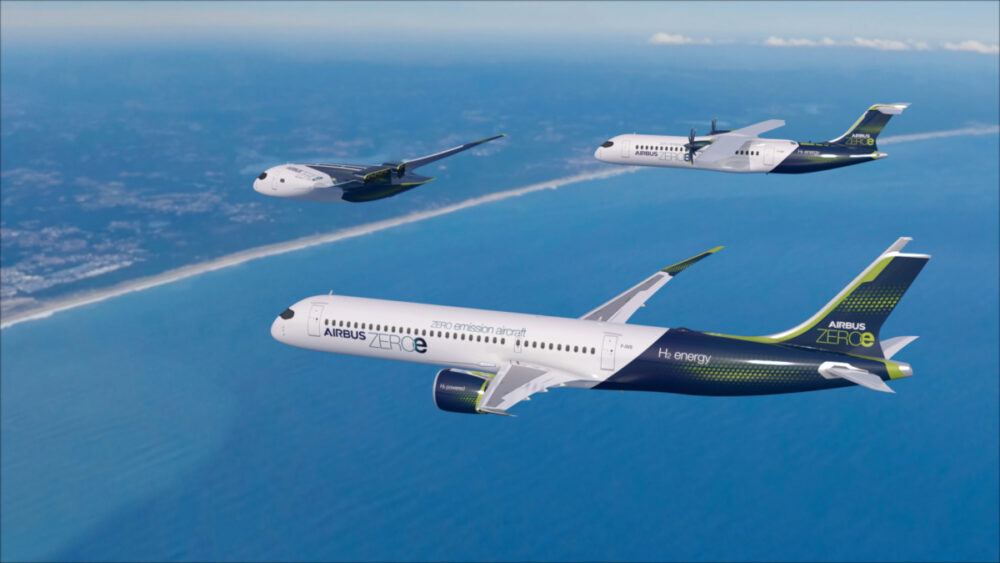To celebrate zero emissions day 2020, Airbus has revealed three concept aircraft, codenamed ZEROe. These hydrogen-powered planes would be the first to produce zero emissions in flight and could revolutionize air transport for the future. Here’s what you need to know.

The world’s first zero emission aircraft
European planemaker Airbus has unveiled three concepts for aircraft that could fly with zero emissions. These commercial planes are designed to fill every niche in the commercial aviation sector, and the planemaker says they could be ready to enter service as soon as 2035.
All rely on hydrogen as a primary fuel source, something which comes with its own set of challenges. However, Airbus says it believes that hydrogen is an exceptionally promising future aviation fuel, and that it holds the key to meeting climate goals for the future. Chief executive Guillaume Faury commented in a statement,
“This is a historic moment for the commercial aviation sector as a whole and we intend to play a leading role in the most important transition this industry has ever seen. The concepts we unveil today offer the world a glimpse of our ambition to drive a bold vision for the future of zero-emission flight. I strongly believe that the use of hydrogen – both in synthetic fuels and as a primary power source for commercial aircraft – has the potential to significantly reduce aviation’s climate impact.”
The three concepts are all called ZEROe, and could be the world’s first zero emissions aircraft if they make it to production.
Stay informed: Sign up for our daily aviation news digest.
Concept 1 – the narrowbody replacement
The first design is a turbofan aircraft with a range of around 2,000 nautical miles. Airbus says this aircraft would be powered by a modified gas-turbine engine, operating entirely on hydrogen as an alternative to jet fuel.




The aircraft would be perfect for transcontinental missions, seating around 120 up to 200 passengers. The planemaker says that the fuel – liquid hydrogen – would be safely stored in tanks behind the rear pressure bulkhead. It could be the A320 successor the world needs.
Concept 2 – the regional turboprop
The second concept from the planemaker is a turboprop aircraft, clearly targeted to regional markets with a capacity of around 100 passengers. Despite being a small plane, it would have a range of around 1,000 nautical miles, making it ideal for the short-haul marketplace.




Like the narrowbody, this aircraft would be fueled by hydrogen via modified gas-turbine engines. The propulsion would rely on combustion of the hydrogen fuel.
Concept 3 – the breakout concept
While the first two concepts look pretty standard in terms of aircraft design, the third is a step out of the box for aerospace. Airbus has presented the blended wing concept aircraft as the third zero emissions idea, something which it floated to the world earlier this year.




The unusual design would make for a high capacity of seating, up to 200 passengers. Airbus says that the wide fuselage would present more options for hydrogen storage and distribution, as well as making some interesting possibilities for cabin design.
Challenges to overcome
While these concepts are interesting to see, Airbus concedes that there are some significant challenges to overcome if they are to be brought to market. Things like hydrogen storage and transportation, refueling capabilities at airports, and the considerable investment this will require all need to be navigated to realize the dream of a zero emission aircraft. Faury commented,
“These concepts will help us explore and mature the design and layout of the world’s first climate-neutral, zero-emission commercial aircraft, which we aim to put into service by 2035. The transition to hydrogen, as the primary power source for these concept planes, will require decisive action from the entire aviation ecosystem. Together with the support from government and industrial partners we can rise up to this challenge to scale-up renewable energy and hydrogen for the sustainable future of the aviation industry.”
It’s a complex step change, but one which is undoubtedly necessary if the industry is serious about meeting the future needs of the planet. The next step for Airbus will be to evaluate these concepts and technologies to see whether they can be matured into viable products. To explore the roadmap to bring these to market, Airbus will be hosting a presentation on its social media channels at 12:00 UTC today.
What do you make of these aircraft concepts? Let us know in the comments.



